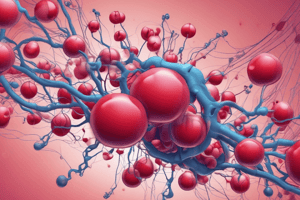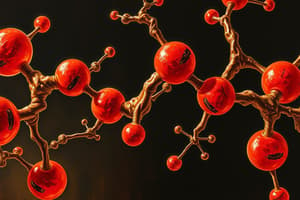Podcast
Questions and Answers
What is the quaternary structure of Hb?
What is the quaternary structure of Hb?
- A trimer of alpha, beta, and gamma globin subunits
- A monomer
- A tetramer of alpha and beta globin subunits
- A dimer of a dimer (α1β1)(α2β2) (correct)
What is the approximate number of amino acids in the globin subunits?
What is the approximate number of amino acids in the globin subunits?
- 200
- 100
- 250
- 150 (correct)
How do the haem groups bind oxygen?
How do the haem groups bind oxygen?
- Through the hydrophobic pocket
- Through the alpha helices
- Through the hydrophilic side of the haem group (correct)
- Through the beta globin subunits
What is the difference between Hb and Mb?
What is the difference between Hb and Mb?
What is the structure of the globin subunits?
What is the structure of the globin subunits?
What is the location of the haem group within the globin?
What is the location of the haem group within the globin?
What is the primary effect of allosteric binding of oxygen to one globin subunit?
What is the primary effect of allosteric binding of oxygen to one globin subunit?
In which conformational state does the globin subunit have a high affinity for oxygen?
In which conformational state does the globin subunit have a high affinity for oxygen?
What is the effect of binding of oxygen to the α1 subunit on the β1 subunit?
What is the effect of binding of oxygen to the α1 subunit on the β1 subunit?
What is the primary reason for cooperative binding of oxygen to hemoglobin in the lungs?
What is the primary reason for cooperative binding of oxygen to hemoglobin in the lungs?
What is the effect of increased site occupancy of Hb on its affinity for oxygen?
What is the effect of increased site occupancy of Hb on its affinity for oxygen?
What is the primary consequence of the conformational change in the globin subunit upon binding of oxygen?
What is the primary consequence of the conformational change in the globin subunit upon binding of oxygen?
What percentage of carbon dioxide is dissolved in blood plasma?
What percentage of carbon dioxide is dissolved in blood plasma?
What is the primary mechanism by which carbon dioxide is converted to bicarbonate in erythrocytes?
What is the primary mechanism by which carbon dioxide is converted to bicarbonate in erythrocytes?
What is the effect of increasing [H+] on the ability of haemoglobin to bind oxygen?
What is the effect of increasing [H+] on the ability of haemoglobin to bind oxygen?
What is the primary function of the Cl-/HCO3- channel in erythrocytes?
What is the primary function of the Cl-/HCO3- channel in erythrocytes?
What is the percentage of carbon dioxide that is bound to haemoglobin?
What is the percentage of carbon dioxide that is bound to haemoglobin?
What is the result of the increase in [H+] in peripheral tissues?
What is the result of the increase in [H+] in peripheral tissues?
What is the primary product of the reaction between carbon dioxide and water in erythrocytes?
What is the primary product of the reaction between carbon dioxide and water in erythrocytes?
What is the significance of the Bohr effect in peripheral tissues?
What is the significance of the Bohr effect in peripheral tissues?
What is the primary reason for the conformation change in deoxyHbS?
What is the primary reason for the conformation change in deoxyHbS?
What is the consequence of polymers of HbS on the erythrocyte membrane?
What is the consequence of polymers of HbS on the erythrocyte membrane?
What is the result of low Fe2+ intake in the diet?
What is the result of low Fe2+ intake in the diet?
What is the characteristic of α-thalassaemia?
What is the characteristic of α-thalassaemia?
What is the name of the haemoglobin formed in α-thalassaemia in adults?
What is the name of the haemoglobin formed in α-thalassaemia in adults?
What is the consequence of sickle-shaped cells in capillaries?
What is the consequence of sickle-shaped cells in capillaries?
What is the primary reason behind monitoring haemoglobin levels in individuals with type 1 diabetes?
What is the primary reason behind monitoring haemoglobin levels in individuals with type 1 diabetes?
What is the consequence of glucose reacting with plasma proteins in diabetic individuals?
What is the consequence of glucose reacting with plasma proteins in diabetic individuals?
What is the characteristic of haemoglobin that makes it suitable for monitoring glucose levels?
What is the characteristic of haemoglobin that makes it suitable for monitoring glucose levels?
What is the genetic basis of sickle cell anaemia?
What is the genetic basis of sickle cell anaemia?
What is the effect of the glutamic acid to valine substitution in sickle cell anaemia?
What is the effect of the glutamic acid to valine substitution in sickle cell anaemia?
What is the characteristic of haemoglobin in sickle cell anaemia?
What is the characteristic of haemoglobin in sickle cell anaemia?
What is the difference between sickle cell disease and sickle cell trait?
What is the difference between sickle cell disease and sickle cell trait?
What is the consequence of the formation of sickle-shaped cells in sickle cell anaemia?
What is the consequence of the formation of sickle-shaped cells in sickle cell anaemia?
Flashcards are hidden until you start studying
Study Notes
Structure of Hemoglobin and Myoglobin
- Hemoglobin (Hb) is a tetramer, consisting of 2 identical beta globin subunits and 2 identical alpha globin subunits.
- Hb is a dimer of a dimer, with the structure (α1β1)(α2β2).
- In adults, Hb is primarily HbA.
- Myoglobin (Mb) is a monomer.
- Mb and Hb have similar structures, consisting of alpha helices and a hydrophobic pocket containing a haem group.
Binding of Oxygen to Hemoglobin
- Each haem group can bind oxygen.
- Allostery occurs when the binding of oxygen to one globin changes the shape of the binding site of another globin.
- The affinity of Hb for oxygen increases as the site occupancy increases.
- When pO2 is high (in the lungs), cooperative binding allows Hb to be fully saturated.
Tense and Relaxed Forms of Hemoglobin
- Each globin subunit can exist in two forms: T (tense) conformation with low affinity for oxygen and R (relaxed) conformation with high affinity for oxygen.
- Binding of oxygen to one subunit causes a conformational change in the subunit, leading to a conformational change of a second subunit to the R state.
- For example, binding of oxygen to α1 changes the conformation of α1, which in turn changes β1 to the R state, increasing its affinity for oxygen.
Transportation of Carbon Dioxide in Blood
- A small amount of carbon dioxide is dissolved in blood plasma.
- Carbon dioxide freely crosses the erythrocyte plasma membrane.
- Most carbon dioxide is converted to carbonic acid by carbonic anhydrase in erythrocytes.
- Carbonic acid dissociates to bicarbonate, which is exported via the Cl-/HCO3- channel.
- Some carbon dioxide reversibly binds to Hb to form carbaminohaemoglobin.
Bohr Effect
- The ability of Hb to bind oxygen decreases as the [H+] increases.
- The ability of Hb to bind oxygen decreases as the pH decreases.
- This is a physiologically important biological adaptation, allowing Hb to release more oxygen in peripheral tissues.
Impact of [H+] on Oxygen Binding of Hemoglobin in the Periphery
- In peripheral tissues, Hb releases more oxygen due to the increased [H+] resulting from carbon dioxide production.
- This is important for the delivery of oxygen to tissues.
Type 1 Diabetes and Hemoglobin
- Hemoglobin is monitored in type 1 dependent diabetes because glucose can cause non-enzymatic glycosylation of plasma proteins.
- Glycosylated Hb (HbA1c) is used to monitor glucose levels over a three-month period.
Sickle Cell Anaemia
- Sickle cell anaemia is a recessively inherited anaemia characterised by the formation of sickle-shaped cells.
- It is caused by an inherited mutation of β-globin, resulting in the substitution of glutamic acid with valine at position 6.
- This creates hydrophobic "sticky" patches on the normally charged surface of the β-globin.
HbS Aggregation
- A conformation change in deoxyHb results in the alpha helix containing position 6 shifting to the surface.
- In HbS, the valine at position 6 is not stabilised by hydrogen bonds with the aqueous environment, leading to aggregation of two haemoglobins.
- This aggregation continues to form polymers.
Formation of Sickle-Shaped Cells
- The polymers of HbS disrupt the erythrocyte membrane and prevent deformability, resulting in sickle-shaped cells.
- These cells can be trapped in capillaries and lyse.
Haemoglobin and Other Diseases
- Low Fe2+ intake in the diet can lead to anaemia.
- Hereditary haemolytic anaemia can result from an imbalance of globin chain production.
- α-thalassaemia is characterised by deficient α-globin production, leading to excess β chains.
- β-thalassaemia is characterised by deficient β-globin production.
- Hereditary Persistence of Fetal Haemoglobin (HPFH) is a rare condition in which fetal haemoglobin is persistently produced in adults.
Studying That Suits You
Use AI to generate personalized quizzes and flashcards to suit your learning preferences.




